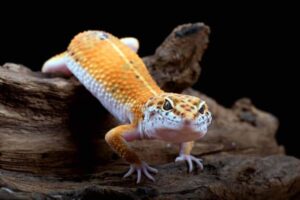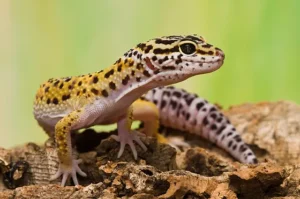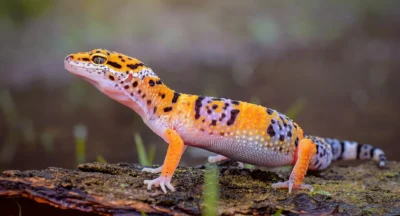Have you ever found your leopard gecko lying still in its enclosure, seemingly unresponsive? Before panic sets in, it’s essential to consider the possibility that your gecko might be hibernating rather than deceased.
Understanding the signs of hibernation versus those of illness or death is crucial for every leopard gecko owner. In this guide, we’ll delve into the fascinating world of leopard gecko behavior to help you discern whether your beloved pet is simply taking a winter snooze or if there’s a cause for concern. So, let’s explore the question: Is my leopard gecko dead or hibernating?
Is my leopard gecko dead or hibernating?

Determining whether your leopard gecko is dead or hibernating can be a daunting task, but there are several signs to look out for that can help you discern between the two possibilities.
- Temperature and Environment: Leopard geckos are cold-blooded creatures, so their activity level is heavily influenced by temperature. If your gecko’s enclosure is too cold, it may enter a state of brumation, a reptilian form of hibernation. Ensure that your gecko’s enclosure maintains an appropriate temperature range (usually between 75-85°F or 24-29°C) to prevent hibernation.
- Behavior: During hibernation or brumation, leopard geckos will exhibit significantly reduced activity. They may spend extended periods lying still or hiding in their shelters. However, if your gecko shows no signs of movement or responsiveness for an extended period, it’s essential to monitor closely for other indicators of life.
- Breathing and Heartbeat: Carefully observe your gecko’s chest for subtle movements that indicate breathing. Additionally, place your ear close to your gecko’s body to listen for a faint heartbeat. If you detect breathing or a heartbeat, your gecko is likely alive but in a dormant state.
- Physical Appearance: A healthy leopard gecko should have vibrant skin coloration and plump, rounded body shape. If your gecko appears emaciated, discolored, or shows signs of injury, it may be a cause for concern. However, during hibernation, geckos may lose some body fat, so slight weight loss is normal.
- Response to Stimuli: Gently touch your gecko or make soft noises to see if it responds. In some cases, even during hibernation, geckos may exhibit slight reactions such as twitching or subtle movements.
If you’re uncertain about your gecko’s condition, it’s always best to consult with a veterinarian experienced in reptile care. They can provide expert guidance and assistance in assessing your gecko’s health and well-being. Remember, proactive monitoring and attentive care are essential for ensuring the health and happiness of your leopard gecko.
What is hibernation?
Hibernation is a natural physiological response that many animals, including certain reptiles like leopard geckos, undergo to survive periods of unfavorable environmental conditions, such as cold temperatures and scarcity of food. During hibernation, an animal enters a state of reduced metabolic activity, allowing it to conserve energy and endure harsh conditions until more favorable circumstances return.
For leopard geckos, hibernation is often referred to as brumation. Brumation typically occurs in response to seasonal changes, especially when temperatures drop. During brumation, a leopard gecko’s metabolic rate slows down significantly, leading to decreased activity levels, reduced appetite, and sometimes prolonged periods of dormancy.
While hibernating or brumating, leopard geckos may retreat to a burrow or hideaway within their enclosure, where they remain relatively inactive. They may also seek out cooler areas of their habitat to facilitate the slowing down of their metabolism.
It’s important to note that not all leopard geckos will go through a hibernation or brumation period, especially those kept in controlled indoor environments with stable temperatures year-round. However, in regions with distinct seasons or for geckos kept in outdoor enclosures, hibernation may be a natural part of their annual cycle.
Proper care and monitoring are crucial during hibernation or brumation periods to ensure the health and well-being of leopard geckos. Owners should maintain appropriate environmental conditions and provide access to water, even if the gecko shows reduced activity and appetite.
Additionally, it’s essential to monitor your gecko closely for any signs of illness or distress during this time. If you’re uncertain about your gecko’s condition or care requirements during hibernation, consulting with a veterinarian experienced in reptile care is recommended.
Signs of Hibernation in Leopard Geckos
Differentiating Between Hibernation and Death

Differentiating between hibernation and death in a leopard gecko can be challenging but important for ensuring the well-being of your pet. Here are some key factors to consider when trying to determine whether your leopard gecko is hibernating or deceased:
- Body Temperature: Check the temperature of your gecko’s body. If it feels cold to the touch, it may be a sign of death, as leopard geckos in hibernation typically maintain a slightly warmer body temperature than room temperature. However, keep in mind that a gecko in hibernation may still feel cool, so this should not be the sole indicator.
- Breathing: Observe for any signs of breathing. Place your hand gently on your gecko’s chest to feel for subtle movements that indicate breathing. If you detect no breathing after careful observation, it could suggest death. However, be patient, as breathing can be very slow during hibernation.
- Heartbeat: Listen closely for a heartbeat by placing your ear near your gecko’s body. While leopard geckos have a slow heart rate, especially during hibernation, you may still be able to detect a faint heartbeat. If you cannot detect any heartbeat after careful listening, it could indicate death.
- Physical Appearance: Assess your gecko’s physical condition. Look for any signs of trauma, injury, or decay that could indicate death. A healthy leopard gecko typically has vibrant skin coloration and a plump body. However, during hibernation, they may lose some body fat, so slight weight loss is normal.
- Responsiveness: Try gently touching or moving your gecko to see if it responds. While leopard geckos in hibernation may be less responsive, they may still exhibit slight reactions, such as twitching or movement of the limbs. A lack of any response could suggest death, but be patient and observe closely.
- Duration: Consider the duration of inactivity. If your gecko has been motionless for an extended period, it may be more likely to indicate death, especially if other signs of life are not present. However, leopard geckos in hibernation can remain inactive for weeks or even months, so consider the time frame within the context of hibernation behavior.
If you’re uncertain about your gecko’s condition, it’s always best to consult with a veterinarian experienced in reptile care for proper assessment and guidance. They can provide expert advice and help you determine the best course of action for your pet’s health and well-being.
Steps to Confirm Hibernation and Ensure Well-being
Here are steps to confirm hibernation and ensure the well-being of your leopard gecko:
- Observe Behavior: Pay close attention to your leopard gecko’s behavior. Note any significant changes, such as decreased activity, reduced appetite, or seeking out cooler areas of the enclosure.
- Check Temperature: Confirm that the temperature within the enclosure is appropriate for hibernation. While leopard geckos can tolerate slightly cooler temperatures during hibernation, ensure it doesn’t drop too low. Use a thermometer to monitor temperatures regularly.
- Provide Hiding Places: Offer hiding spots within the enclosure where your gecko can retreat during hibernation. These hiding spots should be located in cooler areas and mimic natural burrows or shelters.
- Ensure Hydration: Even though leopard geckos may drink less during hibernation, it’s crucial to provide access to fresh water at all times. Ensure the water dish is clean and filled regularly.
- Offer Food: While leopard geckos may eat less or stop eating altogether during hibernation, continue offering food periodically. Offer small amounts of appropriate prey, such as crickets or mealworms, and remove uneaten food promptly.
- Monitor Weight: Keep track of your gecko’s weight during hibernation. While some weight loss is normal, excessive or rapid weight loss could indicate health issues. Weigh your gecko regularly and consult a veterinarian if you notice significant changes.
- Check Vital Signs: Confirm signs of life by checking for breathing and heartbeat. Gently observe your gecko’s chest for subtle movements indicating breathing and listen closely for a faint heartbeat.
- Minimize Disturbance: Minimize handling and other disturbances to allow your gecko to rest undisturbed during hibernation. Avoid unnecessary stressors that could impact its well-being.
- Be Patient: Leopard geckos may enter hibernation for weeks or even months, depending on environmental conditions and individual factors. Be patient and allow your gecko to follow its natural hibernation cycle.
- Seek Veterinary Advice: If you’re unsure about your gecko’s condition or have concerns about its health during hibernation, consult a veterinarian experienced in reptile care. They can provide guidance and ensure your gecko’s well-being.
By following these steps and providing appropriate care, you can confirm hibernation in your leopard gecko and ensure its well-being throughout this dormant period.
Conclusion
Determining whether your leopard gecko is dead or hibernating requires careful observation and consideration of various factors. By monitoring behavior, checking vital signs, and providing appropriate care, you can confirm hibernation and ensure the well-being of your pet.
Remember, if you’re unsure or have concerns, seeking veterinary advice is always recommended. So, if you find yourself asking, “Is my leopard gecko dead or hibernating,” follow these steps to provide the best care for your beloved pet.

